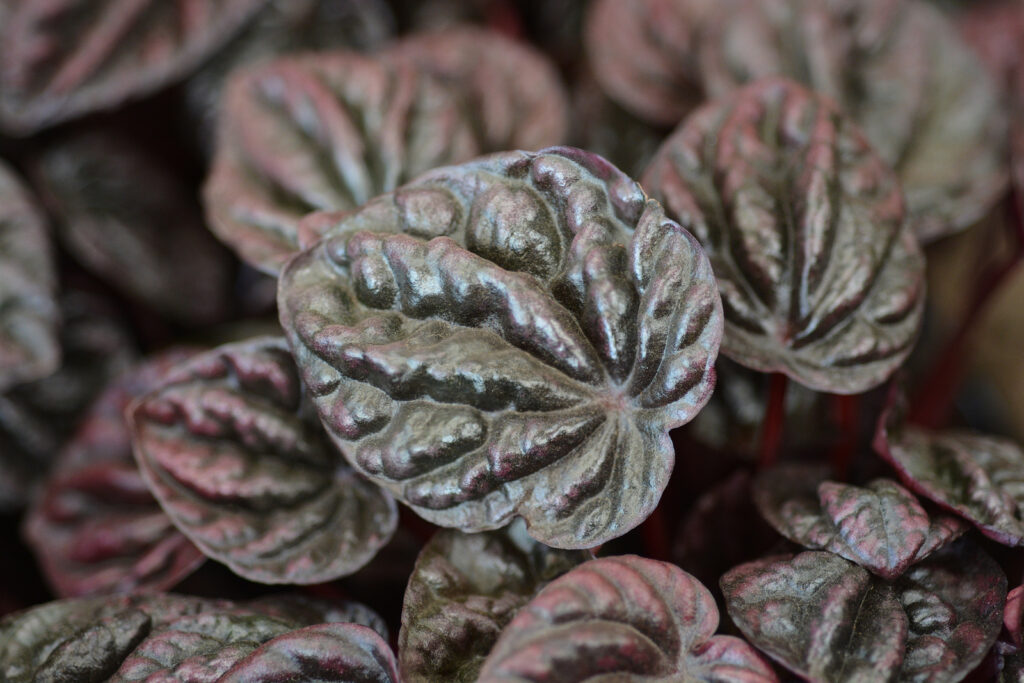Peperomia is a genus of small, compact tropical plants. Cultivars come in a wide range of leaf textures and patterns. Most have fleshy, usually long-stalked deeply textured leaves that can be solid green or purple or green with silver stripes.
Peperomia are rosette-forming. They grow erect. Leaves are elliptic to ovate or heart-shaped and usually appear in whorls. Peperomia produces small white or greenish-white flowers on spikes. Flowering is erratic but usually in summer.
Peperomia thrives in warm, bright spots with extra humidity. It grows in tropical climates in partial shade. In temperate regions, it is grown as a houseplant needing bright indirect light.
Peperomia is a genus of about 1,000 species of evergreen, sometimes succulent plants. They are found worldwide in various habitats from forests to near-desert conditions.
Get to know Peperomia
- Plant type: Tropical evergreen perennial
- Growing Zones and range: Zones 10-11
- Hardiness: Tender
- Optimal growing temperature: day 68° to 80°F (20°-27°C), night 55° to 68°F (13°-20°C)
- Height and width: 8 inches (20cm) tall and 6 inches (15cm) wide depending on variety; trailing types can grow to 4 feet (1.2m) long
- Foliage: Heart-shaped, thick leaves, some waxy and some crinkled with variegations; vining or bushy stems.
- Flowers: Occasionally produce thin pink stems topped with narrow, creamy-white flower spikes.
- Bloom time: Usually summer, can be erratic
- Uses: Houseplant; tropical groundcover or in a border
- Common name: Peperomia
- Botanical name: Peperomia spp.
- Family: Piperaceae
- Origin: Tropical and subtropical regions worldwide
Where to plant Peperomia
- Light outdoors: Grow peperomia outdoors in partial shade.
- Light indoors: Grow Peperomia in filtered light, no direct sun, from nothern, eastern, or western exposure. Peperomias grow well under fluorescent light.
- Soil outdoors: Grow Peperomia in humus-rich, moist but well-drained soil.
- Soil indoors: Plant peperomia in commercial potting mix.

Planting and spacing Peperomia
- Grow peperomias in clay pots.
- Space peperomias 6 inches (15cm) apart in the garden.
How to water and feed Peperomia
- Allow the soil to dry out between waterings to prevent root rot. Soil that is too dry will result in leaf drop.
- Give peperomia dilute fertilizer monthly in spring and fall.
- To increase humidity around peperomia set plants on a tray with pebbles and water.
Growing Peperomia as a houseplant
- Grow solid-colored Peperomia in limited to bright light and protection from the summer sun; grow variegated plants in bright light.
- Insufficient light can cause stems to become weak and spindly.
- Peperomia needs average to warm room temperature and medium to high humidity.
- The soil should be allowed to dry between waterings; too much water can cause leaves to drop.
- Apply fertilizer once a month in spring and summer.
Peperomia pests and diseases
- Check Peperomia for mealybugs, mites, whiteflies, and slugs.
- Overwatering can cause stem rot.
Peperomia care
- Peperomias rots easily if overwatered or if water stands on the leaves.
- Tan patches on leaves are a sign of sunburn; pinch off damaged leaves and move the plat to a spot out of the direct sun.
Peperomia propagation
- Divide clump-forming types; take leaf or stem cuttings from upright or vining types.
Peperomia varieties to grow
- Peperomia argyreia, watermelon peperomia. Grows to 12 inches tall; leaves to 5 inches long are pointed at the tips; thick, waxy and dark green leadew with silver lines that resemble the parkings of watermelon; 3 inch flower spikes are white.
- P. caperata, emerald ripple peperomia. Bushy, mounded plant grows to 6 inchs tall; heart-shaped leaves with wrinkled texture are deep green on the upper surfaces and pale gray-green on the undersides; 4 inch flower spikes are white; a popular cultivar.
- P. griseoargentea is ivy peperomia.
- P. obtusifolia, baby rubber plant. Grows to 8 inches tall; has oval leaves metallic green with silver stripes to 3 inches long; flowers spikes are white. Cultivar ‘Variegata’ has green leaves with creamor yellow margins; some leaves are completely yellow.
- P. orba, pixie peperomia. Compact, rounded plant with stems to 7 inches long; glossy green oval leaves with faint frya mottling; sometimes has white flower spikes to 6 inches long/.
- P. scandens, philodendron peperomia; Trainling plant with stems to several feet long; heart-shaped leaves are light green; rarely flowers indoors. Cultivar ‘Variegata’ has light gren leaves with cream margins.



